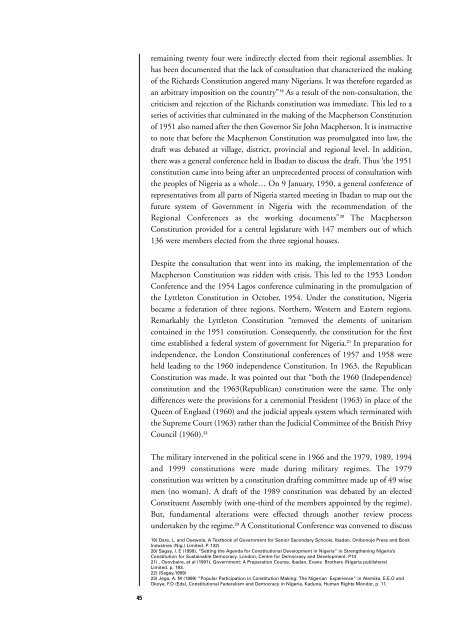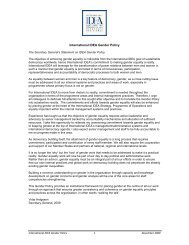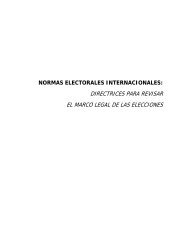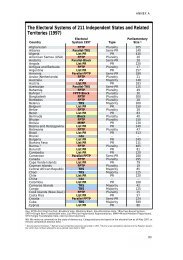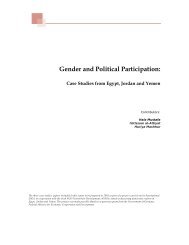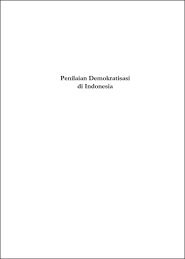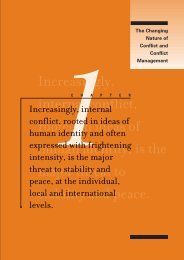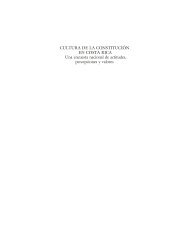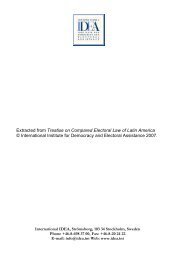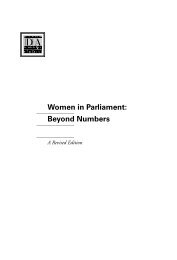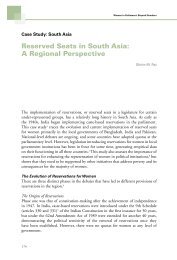The Role of State Constitutions in Protecting ... - International IDEA
The Role of State Constitutions in Protecting ... - International IDEA
The Role of State Constitutions in Protecting ... - International IDEA
You also want an ePaper? Increase the reach of your titles
YUMPU automatically turns print PDFs into web optimized ePapers that Google loves.
ema<strong>in</strong><strong>in</strong>g twenty four were <strong>in</strong>directly elected from their regional assemblies. It<br />
has been documented that the lack <strong>of</strong> consultation that characterized the mak<strong>in</strong>g<br />
<strong>of</strong> the Richards Constitution angered many Nigerians. It was therefore regarded as<br />
an arbitrary imposition on the country” 19 As a result <strong>of</strong> the non-consultation, the<br />
criticism and rejection <strong>of</strong> the Richards constitution was immediate. This led to a<br />
series <strong>of</strong> activities that culm<strong>in</strong>ated <strong>in</strong> the mak<strong>in</strong>g <strong>of</strong> the Macpherson Constitution<br />
<strong>of</strong> 1951 also named after the then Governor Sir John Macpherson. It is <strong>in</strong>structive<br />
to note that before the Macpherson Constitution was promulgated <strong>in</strong>to law, the<br />
draft was debated at village, district, prov<strong>in</strong>cial and regional level. In addition,<br />
there was a general conference held <strong>in</strong> Ibadan to discuss the draft. Thus ‘the 1951<br />
constitution came <strong>in</strong>to be<strong>in</strong>g after an unprecedented process <strong>of</strong> consultation with<br />
the peoples <strong>of</strong> Nigeria as a whole… On 9 January, 1950, a general conference <strong>of</strong><br />
representatives from all parts <strong>of</strong> Nigeria started meet<strong>in</strong>g <strong>in</strong> Ibadan to map out the<br />
future system <strong>of</strong> Government <strong>in</strong> Nigeria with the recommendation <strong>of</strong> the<br />
Regional Conferences as the work<strong>in</strong>g documents” 20 <strong>The</strong> Macpherson<br />
Constitution provided for a central legislature with 147 members out <strong>of</strong> which<br />
136 were members elected from the three regional houses.<br />
Despite the consultation that went <strong>in</strong>to its mak<strong>in</strong>g, the implementation <strong>of</strong> the<br />
Macpherson Constitution was ridden with crisis. This led to the 1953 London<br />
Conference and the 1954 Lagos conference culm<strong>in</strong>at<strong>in</strong>g <strong>in</strong> the promulgation <strong>of</strong><br />
the Lyttleton Constitution <strong>in</strong> October, 1954. Under the constitution, Nigeria<br />
became a federation <strong>of</strong> three regions, Northern, Western and Eastern regions.<br />
Remarkably the Lyttleton Constitution “removed the elements <strong>of</strong> unitarism<br />
conta<strong>in</strong>ed <strong>in</strong> the 1951 constitution. Consequently, the constitution for the first<br />
time established a federal system <strong>of</strong> government for Nigeria. 21 In preparation for<br />
<strong>in</strong>dependence, the London Constitutional conferences <strong>of</strong> 1957 and 1958 were<br />
held lead<strong>in</strong>g to the 1960 <strong>in</strong>dependence Constitution. In 1963, the Republican<br />
Constitution was made. It was po<strong>in</strong>ted out that “both the 1960 (Independence)<br />
constitution and the 1963(Republican) constitution were the same. <strong>The</strong> only<br />
differences were the provisions for a ceremonial President (1963) <strong>in</strong> place <strong>of</strong> the<br />
Queen <strong>of</strong> England (1960) and the judicial appeals system which term<strong>in</strong>ated with<br />
the Supreme Court (1963) rather than the Judicial Committee <strong>of</strong> the British Privy<br />
Council (1960). 22<br />
<strong>The</strong> military <strong>in</strong>tervened <strong>in</strong> the political scene <strong>in</strong> 1966 and the 1979, 1989, 1994<br />
and 1999 constitutions were made dur<strong>in</strong>g military regimes. <strong>The</strong> 1979<br />
constitution was written by a constitution draft<strong>in</strong>g committee made up <strong>of</strong> 49 wise<br />
men (no woman). A draft <strong>of</strong> the 1989 constitution was debated by an elected<br />
Constituent Assembly (with one-third <strong>of</strong> the members appo<strong>in</strong>ted by the regime).<br />
But, fundamental alterations were effected through another review process<br />
undertaken by the regime. 23 A Constitutional Conference was convened to discuss<br />
19) Dare, L. and Oyewole, A Textbook <strong>of</strong> Government for Senior Secondary Schools. Ibadan, Onibonoje Press and Book<br />
Industries (Nig.) Limited. P. 132)<br />
20) Sagay, I. E (1999), “Sett<strong>in</strong>g the Agenda for Constitutional Development <strong>in</strong> Nigeria” <strong>in</strong> Strengthen<strong>in</strong>g Nigeria’s<br />
Constitution for Susta<strong>in</strong>able Democracy. London, Centre for Democracy and Development. P14<br />
21) , Oyovbaire, et al (1991), Government: A Preparation Course, Ibadan, Evans Brothers (Nigeria publishers)<br />
Limited. p. 193.<br />
22) (Sagay,1999)<br />
23) Jega, A. M (1999) “Popular Participation <strong>in</strong> Constitution Mak<strong>in</strong>g: <strong>The</strong> Nigerian Experience” <strong>in</strong> Alemika, E.E.O and<br />
Okoye, F.O (Eds), Constitutional Federalism and Democracy <strong>in</strong> Nigeria, Kaduna, Human Rights Monitor, p. 11.<br />
45


